Nizam of Hyderabad
| Nizam of Hyderabad | |
|---|---|
 Coat of Arms of the Nizam of Hyderabad | |
| Incumbent | |
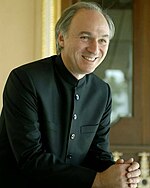 | |
| Azmet Jah (pretender) since 14 January 2023 | |
| Details | |
| Style | Osman Ali Khan |
| Formation | 31 July 1724 |
| Abolition | 17 September 1948 |
| Residence | Chowmahalla Palace |
| Appointer | Hereditary |
| Pretender(s) | Azmet Jah |

Nizam of Hyderabad was the title of the ruler of
The
When the
The Asaf Jahi dynasty had only seven recognized rulers, but there was a period of 13 unstable years after the rule of the first Nizam when two of his sons,
History
Etymology
The title Nizam comes from the
Descent
According to
Ghazi Uddin Khan rose to become a General of the

After Aurangzeb's death and during the war of succession, Qamaruddin and his father remained neutral thus escaping the risk of being on the losing side; they remained marginal players in the Mughal court during the reigns of Bahadur Shah I (1707–12) and Jahandar Shah (1712–13). Their successor Farrukhsiyar (1713–19) appointed Qamaruddin the governor of Deccan in 1713, awarding him the title Nizam-ul-Mulk. However, the governorship was taken away two years later and Qamaruddin withdrew to his estate in Moradabad. Under the next emperor, Muhammad Shah (1719–48), Qamaruddin accepted the governorship of Deccan for the second time in 1721. The next year, following the death of his uncle Muhammad Amin Khan, a power-broker in the Mughal Court, Qamaruddin returned to Delhi and was made the wazir (prime minister). According to historian Faruqui, his tenure as prime minister was undermined by his opponents and a rebellion in Deccan was engineered against him. In 1724, the Nizam returned to Deccan to reclaim his base, in the process making a transition to a semi-independent ruler.[12]
Reign
In 1724, Asaf Jah I defeated


Following the decline of the Mughal power, the region of Deccan saw the rise of the
In 1805, after the East India Company's victory in the Second Anglo-Maratha War, the Nizam of Hyderabad came under their protection.[citation needed]
In 1903, the Berar region of the state was separated and merged into the Central Provinces of British India, to form the Central Provinces and Berar.
The last Nizam of Hyderabad state,
In 1947, at the time of the partition of India, the British government offered the 565 princely states in the sub-continent the options of acceding to either India or Pakistan or remaining independent.
End of the dynasty

After the
All Nizams are buried in royal graves at the
State wealth

During the period of the Nizams' rule,
One example of the wealth of the Nizams is the
The state had its currency known as the Hyderabadi rupee, until 1951.[28] The pace at which the last Nizam Mir Osman Ali Khan amassed wealth made him one of the world's richest men in 1937, also known for his miserliness.[26] He was estimated to be worth ₹ 660 crores (roughly US$2 billion by the then exchange rates).[29] According to the Forbes All-Time Wealthiest List of 2008, Nizam Mir Osman Ali Khan is the fifth richest man in recorded history per the figures, with an estimated worth of US$210.8 billion adjusted by Forbes as per the growth of the US GDP since that period and the present exchange rate of the US dollar against the Indian rupee.[28]
Institutions
The Nizams set up numerous institutions in the name of the dynasty including hospitals, schools, colleges, and universities that imparted education in Urdu.[28] Inspired by the Indian Civil Service, the Nizams established their own local Hyderabad Civil Service.[citation needed]
Infrastructure
The Nizams commissioned engineering projects such as large reservoirs like Osman Sagar and Himayat Sagar. Survey work on the Nagarjuna Sagar Dam was also initiated during this time, although the actual work was completed under the aegis of the Government of India in 1969.[30][31]
They also gave Hyderabad its railway network - the Nizam's Guaranteed State Railway[32] which helped in setting up various industries.
Other landmarks include the
Donation for compilation of Mahabharata
In 1932, there was a need for money for the publication of Mahabharata in the Bhandarkar Oriental Research Institute located in Pune. A formal request was made to the 7th Nizam, who granted Rs. 1000 per year for 11 years.[34]
He also gave Rs 50,000 for construction of the guest house which stands today as "Nizam's guest house".[35][36]
Donation to Hindu Temples
The Nizams donated Rs. 82,825 to the
The 7th Nizam also donated Rs. 8,000 to Tirupati Balaji Temple as yearly grants.[38]
A donation of Rs. 50,000 towards the reconstruction of
Palaces
The Asaf Jahis were prolific builders. Their palaces are listed below:
- Chowmahalla Palace - Official residence of early Nizams
- Purani Haveli
- King Kothi Palace
- Mahboob Mansion
- Falaknuma Palace
- Bella Vista
- Hill Fort Palace
- Chiran Palace
- Saifabad Palace
- Hyderabad House, New Delhi
- Nizam Palace, Kolkata
List of Nizams of Hyderabad (1724–1948)
| Image | Titular Name | Personal Name | Date of birth | Nizam From | Nizam Until | Date of death |
|---|---|---|---|---|---|---|
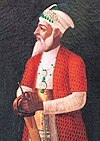 |
Nizam-ul-Mulk, Asaf Jah I نظامالملک آصف جاہ |
Mir Qamar-ud-din Khan
|
20 August 1671 | 31 July 1724 | 1 June 1748 | |
 |
Nasir Jung نصیرجنگ |
Mir Ahmed Ali Khan
|
26 February 1712 | 1 June 1748 | 16 December 1750 | |
 |
Muzaffar Jung مظفرجنگ |
Mir Hidayat Muhi-ud-din Sa'adullah Khan
|
? | 16 December 1750 | 13 February 1751 | |
 |
Salabat Jung صلابت جنگ |
Mir Sa'id Muhammad Khan
|
24 November 1718 | 13 February 1751 | 8 July 1762 (deposed) |
16 September 1763 |
 |
Nizam-ul-Mulk, Asaf Jah II نظامالملک آصف جاہ دوم |
Mir Nizam Ali Khan | 7 March 1734 | 8 July 1762 | 6 August 1803 | |
 |
Sikander Jah, Asaf Jah III سکندر جاہ ،آصف جاہ سوم |
Mir Akbar Ali Khan
|
11 November 1768 | 6 August 1803 | 21 May 1829 | |
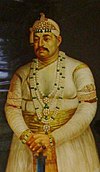 |
Nasir-ud-Daula, Asaf Jah IV ناصر الدولہ ،آصف جاہ چہارم |
Mir Farqunda Ali Khan
|
25 April 1794 | 21 May 1829 | 16 May 1857 | |
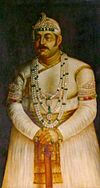 |
Afzal-ud-Daula, Asaf Jah V افضال الدولہ ،آصف جاہ پنجم |
Mir Tahniyath Ali Khan
|
11 October 1827 | 16 May 1857 | 26 February 1869 | |
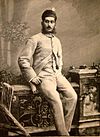 |
Asaf Jah VI آصف جاہ ششم |
Mir Mahbub Ali Khan
|
17 August 1866 | 26 February 1869 | 29 August 1911 | |
 |
Asaf Jah VII آصف جاہ ہفتم |
Mir Osman Ali Khan
|
6 April 1886 | 29 August 1911 | 17 September 1948 (deposed) |
24 February 1967 |
Descendants of the last Nizam
The last Nizam had 34 children, including 16 sons and 18 daughters[40][41][42][43][44][45]
The
His eldest son was Azam Jah (21 February 1907 – 9 October 1970),was the Prince of Berar.[47]
Whereas, his second son
Family tree
- Hyderabad Cityhis new capital on 7 December 1724.
 II. Humayun Jah, Nizam ud-Daula, Nawab Mir Ahmad 'Ali Siddiqi, Khan Bahadur, Nasir Jang, Nawab Subedar of the Deccan, 2nd Nizam of Hyderabad (26 February 1712 – k. by the Nawab of Kadapa 16 December 1750; r. 1 June 1748 – 16 December 1750).
II. Humayun Jah, Nizam ud-Daula, Nawab Mir Ahmad 'Ali Siddiqi, Khan Bahadur, Nasir Jang, Nawab Subedar of the Deccan, 2nd Nizam of Hyderabad (26 February 1712 – k. by the Nawab of Kadapa 16 December 1750; r. 1 June 1748 – 16 December 1750).- Sahibzadi Khair un-nisa Begum. Married Nawab Talib Muhi ud-din Mutasawwil Khan Bahadur, Muzaffar Jang:
 IV. Amir ul-Mamalik, Asaf ud-Daula, Nawab Said Muhammad Siddiqi, Khan Bahadur, Zaffar Jang, Nawab Subadar of the Deccan, 4th Nizam of Hyderabad (November 1718 – 16 September 1763; r. 13 February 1751 – 8 July 1762). Deposed by his younger brother on 8 July 1762 and killed in prison the following year, aged 44.
IV. Amir ul-Mamalik, Asaf ud-Daula, Nawab Said Muhammad Siddiqi, Khan Bahadur, Zaffar Jang, Nawab Subadar of the Deccan, 4th Nizam of Hyderabad (November 1718 – 16 September 1763; r. 13 February 1751 – 8 July 1762). Deposed by his younger brother on 8 July 1762 and killed in prison the following year, aged 44.- Asaf Jah II, Nizam ul-Mulk, Nizam ud-Daula, Nawab Mir Nizam 'Ali Siddiqi, Khan Bahadur, Fath Jang, Sipah Salar, Nawab Subadar of the Deccan, 5th Nizam of Hyderabad (7 March 1734 – 6 August 1803; r. 8 July 1762 – 6 August 1803)
- Asaf Jah III, Muzaffar ul-Mamaluk, Nizam ul-Mulk, Nizam ud-Daula, Nawab Mir Akbar 'Ali Siddiqi, Khan Bahadur, Fulad Jang, 6th Nizam of Hyderabad (11 November 1768 – 21 May 1829; r. 6 August 1803 – 21 May 1829). The first of the dynasty to be officially granted the title of Nizam.
- Asaf Jah IV, Muzaffar ul-Mamaluk, Nizam ul-Mulk, Nizam ud-Daula, Nawab Mir Farkhanda 'Ali Siddiqi, Khan Bahadur [Gufran Manzil], Sipah Salar, Fath Jang, Ayn Waffadar Fidvi-i-Senliena, Iqtidar-i-Kishwarsitan Muhammad Akbar Shah Padshah-i-Ghazi, 7th Nizam of Hyderabad (25 April 1794 – 16 May 1857; r. 21 May 1829 – 16 May 1857).
- GCSI(11 October 1827 – 26 February 1869; r. 16 May 1857 – 26 February 1869). The first of the dynasty to come under British rule.
- GCSI(17 August 1866 – 31 August 1911; r. 26 February 1869 – 31 August 1911). Succeeded his father on 26 February 1869, ruled under a regency until 5 February 1884, when he was invested with full ruling powers by the Viceroy of India.
- MP (6 April 1886 – 24 January 1967; r. 31 August 1911 – 26 January 1950). Granted the style of His Exalted Highness (1 January 1918), the title of Faithful Ally of the British Government (24 January 1918) and Nizam of Hyderabad and of Berar (13 November 1936). The last of the ruling Nizams; ruled absolutely from his accession until 19 September 1948, when the state was formally annexed to the Union. Maintained semi-ruling and semi-autonomous status from then until 23 November 1949, when he accepted the paramountcy of the new Indian government and Constitution and acceded to the Union. Formally lost his sovereignty, ending 230 years of Asaf Jahi rule, upon the formal promulgation of the Constitution on 26 January 1950. Served as Rajpramukhof the new Hyderabad State from 26 January 1950 until 31 October 1956, when the post was abolished. Served as a titular monarch from 26 January 1950 until his death.
- GBE(21 February 1907 – 9 October 1970). Granted the title of His Highness the Prince of Berar (13 November 1936). Passed over in the line of succession in 1967 in favour of his elder son.
 XI. Rustam-i-Dauran, Arustu-i-Zaman, Wal Mamaluk, Asaf Jah VIII, Muzaffar ul-Mamaluk, Nizam ul-Mulk, Nizam ud-Daula, Nawab Mir Barakat 'Ali Siddiqi, Khan Bahadur, Sipah Salar, Fath Jang, 11th Nizam of Hyderabad and Berar (6 October 1933 – 15 January 2023; 11th Nizam: 24 January 1967 – 28 December 1971; dynastic head and pretender since then).
XI. Rustam-i-Dauran, Arustu-i-Zaman, Wal Mamaluk, Asaf Jah VIII, Muzaffar ul-Mamaluk, Nizam ul-Mulk, Nizam ud-Daula, Nawab Mir Barakat 'Ali Siddiqi, Khan Bahadur, Sipah Salar, Fath Jang, 11th Nizam of Hyderabad and Berar (6 October 1933 – 15 January 2023; 11th Nizam: 24 January 1967 – 28 December 1971; dynastic head and pretender since then).
- Azmet Jah, Nawab Mir Muhammad Azmat 'Ali Siddiqi, Khan Bahadur (b. 23 June 1960; appointed Prince of Berar and heir apparent: 2002)
The Nizams' daughters had been married traditionally to young men of the
italics – Considered pretenders by most historians; refrained from exercising traditional authority during their reigns.[citation needed]
Places, things named after and established by the Nizams
Places and things named after the Nizam include
See also
- Asaf Jahi dynasty
- History of Telangana
- History of Hyderabad, India
- Hyderabadi Muslims
- Osman Ali Khan
- Mukarram Jah
- Najaf Ali Khan
- Salar Jung family
- Raja Shamraj Bahadur
References
- ISBN 9780313335396. Archivedfrom the original on 31 January 2020. Retrieved 11 April 2019.
- ISBN 978-0803213449. Archivedfrom the original on 12 February 2020. Retrieved 11 April 2019.
- ISBN 9788171547890. Archivedfrom the original on 28 March 2021. Retrieved 18 November 2020.
- ^ "This day, that year: How Hyderabad became a part of the union of India". 16 September 2018. Archived from the original on 30 December 2018. Retrieved 16 September 2018.
- ^ "Police Action: What happened in Hyderabad State during 1948 and beyond". The Siasat Daily. 9 September 2020. Archived from the original on 16 January 2021. Retrieved 4 January 2021.
- ^ "Azmet Jah coronated as ninth titular Nizam of Hyderabad". India Today. Retrieved 27 November 2023.
- OxfordDictionaries.com. Archived from the originalon 11 February 2018. Retrieved 11 February 2018.
- ISBN 9788187879541. Archivedfrom the original on 25 June 2020. Retrieved 11 February 2018.
- ^ Faruqui, At Empire's End 2013, p. 3–4.
- ^ Lethbridge, The Golder Book of India 1893, p. 179.
- ^ Faruqui, At Empire's End 2013, p. 4–5.
- ^ Faruqui, At Empire's End 2013, pp. 9–13.
- S2CID 142989123.
- ISBN 978-0-231-02580-5. Archivedfrom the original on 6 March 2012. Retrieved 28 February 2018.
- Rao, Sushil (11 December 2009). "Testing time again for the pearl of Deccan". The Times of India. Archived from the original on 10 September 2015. Retrieved 28 February 2018.
- ISBN 978-81-7022-195-1.
- Farooqui, Salma Ahmed (2011). A comprehensive history of medieval India. ISBN 978-81-317-3202-1.
- Malleson, George Bruce (2005). An historical sketch of the native states of India in subsidiary alliance with the British government. Asian Education Services. pp. 280–292. ISBN 978-81-206-1971-5.
- Townsend, Meredith (2010). The annals of Indian administration, Volume 14. BiblioBazaar. p. 467. ISBN 978-1-145-42314-5.
- Farooqui, Salma Ahmed (2011). A comprehensive history of medieval India.
- ISBN 9780313335396. Archivedfrom the original on 31 January 2020. Retrieved 11 April 2019.
- ISBN 978-0803213449. Archivedfrom the original on 12 February 2020. Retrieved 11 April 2019.
- ISBN 9788171547890. Archivedfrom the original on 28 March 2021. Retrieved 18 November 2020.
- ^ "Top 10: Richest Men (of All Time)". inStash. Archived from the original on 19 August 2013. Retrieved 28 September 2014.
- ^ "Police Action in Hyderabad State". AP State Portal. Archived from the original on 15 June 2020. Retrieved 29 February 2020.
- ^ "The last Nizam - Hero or Villain? - Times of India". The Times of India. Archived from the original on 27 March 2020. Retrieved 2 June 2020.
- ^ "Floarl Tribute to Nizam VII". 25 February 2018. Archived from the original on 13 June 2018. Retrieved 9 December 2018.
- ^ "In pictures: 50 years ago, a sea of people turned up for the death of Hyderabad's last Nizam". 24 February 2017. Archived from the original on 23 March 2019. Retrieved 9 December 2018.
- ^ "Hyderabad:silver jubilee durbar". Time. 22 February 1937. Archived from the original on 24 May 2007. Retrieved 15 September 2011.
- ^ a b "Hyderabad:the holdout". Time. 30 August 1948. Archived from the original on 10 November 2011. Retrieved 10 October 2011.
- ^ a b "Richest Indian in history!". Daily Star (United Kingdom). 23 July 2010. Retrieved 15 September 2011. "Making money the royal way". The Economic Times. 23 April 2008. Archived from the original on 14 July 2012. Retrieved 15 September 2011.
- ^ "Why are Jewels Hyderabad Last Nizam Locked RBI Vault in Delhi". 8 April 2017. Archived from the original on 5 August 2020. Retrieved 27 December 2018.
- ^ a b c "Jewel in the crown: a palace fit for a Nizam". The Guardian. 20 February 2011. Archived from the original on 25 January 2016. Retrieved 15 September 2011.
- ^ History of the rupee
- ISBN 978-81-7648-026-0.
- ISBN 978-81-7533-007-8.
- ^ Ifthekar, JS (26 November 2017). "The wheel comes full circle…: A look back at the history of transportation in the city". Telangana Today. Archived from the original on 19 June 2020. Retrieved 25 May 2020.
- ^ "Archived copy" (PDF). Archived (PDF) from the original on 1 April 2019. Retrieved 1 April 2019.
{{cite web}}: CS1 maint: archived copy as title (link) - ^ "Family members rue that Hyderabad has forgotten the last Nizam's contribution to the city". 18 August 2016. Archived from the original on 9 July 2018. Retrieved 9 February 2019.
- ^ "Nizam's Guest House, Bhandarkar Oriental Research Institute, Pune". Archived from the original on 9 July 2018. Retrieved 5 June 2020.
- ^ Ifthekhar, AuthorJS. "Reminiscing the seventh Nizam's enormous contribution to education". Telangana Today. Archived from the original on 26 August 2018. Retrieved 9 February 2019.
- ^ "A 'miser' who donated generously". 20 September 2010. Archived from the original on 5 February 2019. Retrieved 9 February 2019.
- ^ "Nizam gave funding for temples, and Hindu educational institutions". 28 May 2013. Archived from the original on 8 July 2018. Retrieved 9 February 2019.
- ^ "Archived copy". The Hindu. Archived from the original on 28 March 2021. Retrieved 4 June 2020.
{{cite web}}: CS1 maint: archived copy as title (link) - ^ Mir Ayoob Ali Khan (19 February 2018). "Last surviving son of Nizam, Fazal Jah, dies". Archived from the original on 20 February 2018. Retrieved 18 December 2018.
- ^ "Last Surviving son of seventh Nizam passes away in Hyderabad". Archived from the original on 18 December 2018. Retrieved 18 December 2018.
- ^ "Nizam's heirs seek Pakistani intervention to unfreeze bank account". indiatoday. 20 July 2012. Archived from the original on 18 December 2018. Retrieved 18 December 2018.
- ^ Mohla, Anika. "From richest to rags in seven generations". The New Indian Express. Archived from the original on 14 August 2015. Retrieved 18 August 2015.
- ^ "India finally settles £1million Nizam dispute". 12 April 2008. Archived from the original on 11 April 2019. Retrieved 11 April 2019.
- TheGuardian.com. Archivedfrom the original on 9 February 2018. Retrieved 11 April 2019.
- ISBN 978-1-317-87785-1.
- ISBN 978-0-300-21110-8.
- ^ "Niloufer, the beguiling princess of Hyderabad". Archived from the original on 3 January 2019. Retrieved 15 January 2019.
Secondary sources
- Benichou, Lucien D. (2000), From Autocracy to Integration: Political Developments in Hyderabad State, 1938–1948, Orient Blackswan, ISBN 978-81-250-1847-6
- Briggs, Henry George (1861). The Nizam: His History and Relations With the British Government, Volume 1. London: B. Quaritch.
- Farooqui, Salma Ahmed (2011), A Comprehensive History of Medieval India: Twelfth to the Mid-Eighteenth Century, Pearson Education India, pp. 346–, ISBN 978-81-317-3202-1
- Faruqui, Munis D. (2013), "At Empire's End: The Nizam, Hyderabad and Eighteenth-century India", in Richard M. Eaton; Munis D. Faruqui; David Gilmartin; Sunil Kumar (eds.), Expanding Frontiers in South Asian and World History: Essays in Honour of John F. Richards, Cambridge University Press, pp. 1–38, ISBN 978-1-107-03428-0
- Hastings, Fraser (1865). Our Faithful Ally, the Nizam. London: Smith, Elder & Co.
- Lethbridge, Roper (2005) [first published 1893]. "Hyderabad". The Golden Book of India. Aakar Books. p. 179. ISBN 9788187879541.
- Lynton, Harriet Ronken; Rajan, Mohini (1974). The Days of the Beloved. ISBN 978-0-520-02442-7.
- Nayeem, M. A. (1985). Mughal Administration of Deccan Under Nizamul Mulk Asaf Jah, 1720–48 A.D. Indian Council of Historical Research, University of Pune, Dept. of History. ISBN 9788172243258.
- Regani, Sarojini (1988) [First published 1963]. Nizam-British Relations, 1724–1857. New Delhi: Concept Publishing Company. ISBN 978-81-7022-195-1.
- JSTOR 4322137
- Zubrzycki, John (2006). The Last Nizam: An Indian Prince in the Australian Outback. Australia: ISBN 978-0-330-42321-2.
